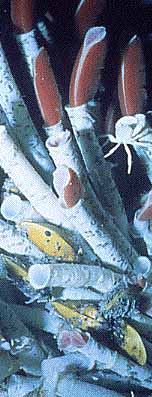Introduction to the Pogonophora
Weird tube worms of the deepest seas


About 80 pogonophoran species are known today, with new species still being discovered. One of the most spectacular zoological discoveries of recent years was the finding in 1977 of giant pogonophoran worms, 1.5 meters long, growing in heated, sulfur-rich water around warm-water vents in the Pacific Ocean, 2600 meters below the surface (pictured at right). These worms are sometimes placed in their own phylum, the Vestimentifera, but they are similar to pogonophorans in most respects, and the current tendency is to group these rift-dwelling worms together with the rest of the Pogonophora into one phylum.
The name Pogonophora is Greek for "beard-bearers," and comes from the fact that many species have from one to many tentacles at the anterior end. These tentacles somewhat resemble the lophophore found in animals like brachiopods and bryozoans, as well as the feeding tentacles of certain chordates. The incompletely known anatomy of pogonophorans was interpreted to show that pogonophorans were chordate relatives. Because pogonophorans live with their lower ends buried in mud, and were broken during the dredging process, it was not until 1964 that a complete pogonophoran was recovered. It turned out that pogonophorans have a segmented posterior end of the body -- the opisthosoma -- that bears setae and resembles an annelid body. The forward part of the body, or prosoma, is unsegmented. Because of the segmented opisthosoma, and because pogonophoran larvae have been found to look very much like annelid larvae, pogonophorans are now considered to be close relatives of the annelids, and are classified with them in a larger group, the Trochozoa.
How do pogonophorans feed with no mouth or gut? Some nutrition is provided by absorbing nutrients directly from the water with the tentacles. But most of a pogonophoran's nutrition is provided by symbiotic bacteria living inside the worm, in a specialized organ known as the trophosome that develops from the embryonic gut. Inside the trophosome, these bacteria oxidize sulfur-containing compounds such as hydrogen sulfide, which pogonophorans absorb through their tentacles -- the bright red color of rift-dwelling pogonophoran tentacles is due to hemoglobin, which absorbs both sulfides and oxygen for the use of the bacteria. The bacteria derive energy from sulfur oxidation, which they use to fix carbon into larger organic molecules, on which the pogonophoran feeds.
The fossil record of pogonophorans may extend back to the Vendian Period; long thin tubes known as sabelliditids have been found in rocks of that age, and somewhat resemble pogonophoran tubes. However, studies on sabelliditid structure have proved inconclusive in determining exactly what these fossils were. A few fossil pogonophoran-like tubes have turned up in later deposits (e.g. Adegoke 1967), but pogonophorans are generally quite rare as fossils.
Visit this Dutch site on the Five Kingdoms for more info on the Pogonophora.
Keep in touch with the Tree of Life for information about the phylogeny and classification of pogonophorans.

Sources:
Adegoke, O.S. 1967. A probable pogonophoran from the early Oligocene of
Oregon. Journal of Paleontology 41(5): 1090-1094.
Ruppert, E.E. and Barnes, R.D. 1994. Invertebrate Zoology. 6th edition. Saunders College Publishing, Fort Worth.

